High school art teacher Melanie Blood inspires students, who in turn inspire her own work
By Meredith Quinn
Art is often one of the first programs on the chopping block for many public school districts. But four-year high school art teacher Melanie Blood reveals that the skills students acquire while talking about their own art and critiquing the work of their peers are among the most helpful and fundamental elements students learn in any classroom.
While a student at the Massachusetts College of Art and Design (MassArt), Blood found her niche in ceramics and mixed media, incorporating materials that others may view as less than beautiful, such as assorted fibers, pieces of cast-off wood, and broken fences. Though she loved showcasing her work, Blood felt unfulfilled and, on a whim, applied to Tufts University, which offers an intensive social justice and art education graduate program in partnership with the School of The Museum of Fine Arts. After the program opened her eyes to different cultures that she had no exposure to at her all-white high school in a small town, Blood decided to pay it forward and devote her career to art education while continuing her own artistic endeavors.
As an art educator at Brockton High School, 30 minutes south of Boston, Blood has found that, as much as her students look up to her for inspiration and mentorship, their stories and spirit inspire her art as well.
Blood recently talked to Art Business News about the role of art in childhood development, the balance she strikes between personal and professional creativity, and how learning art can turn out to be just as practical as learning math.
ART BUSINESS NEWS: Tell me a little about your personal art and inspiration.
MELANIE BLOOD: I started out in college doing primarily ceramics, and, as it developed, I started messing around with firing other materials in a kiln and seeing what would happen. Once I left school, I didn’t have access to kilns, so now I’m doing more unfired clay and working with materials that you wouldn’t necessarily put together.
ABN: Why did you decide to pursue teaching?
MB: In high school, I was going through tough times, and I had an art teacher who inspired me and worked with me nonstop. I wanted to be that person for someone else. In college, opportunities came up to [exhibit my art] here and there, and I loved it, and I loved making work, but I felt like something was missing. I felt like it was almost selfish. I don’t mean that artists are selfish. I mean that, for me, it wasn’t fulfilling enough to just put my work out there. I wanted to be able to inspire kids to do the same thing. When I started learning about education—who it targets and who is being repressed and not considered when talking about curriculum, I knew I wanted to teach in a city. I wanted the challenge of working with kids that don’t have everything super easy and that need someone to motivate them.
ABN: What’s the best thing about being an art teacher?
MB: Knowing that you’re making a huge difference in kids’ lives. It’s not always easy, but then you realize: Even if it’s one kid who wants to come to school just to do art, that’s the most rewarding thing.
ABN: Do your students inspire your art?
MB: Yeah, for sure. I feel like I’m a guidance counselor, a teacher, a parent, a friend. I have a lot of different roles, because the kids don’t have a lot of resources. Some of them have strong family bonds, and some are going through the worst things you could possibly think of. You build relationships and work with them one-on-one, and you realize [these things are] coming out in their art. Those relationships I build with them, the struggles that I face in talking to them, the challenges of trying to be that mentor and trying to help them put that into their art is what my work is about now. It has shifted from being about family connections to connections between me and my students and connections that I see between them and in their community. You can have very, very strong kids, but you don’t really understand what’s going on in their lives and see that they’re really these fragile kids that have to maintain this structure but are also on the verge of falling apart. It’s interesting [to see] how resilient they are in trying to overcome different boundaries and hardships.
So my work has become strong, geometric shapes but also things that are very fragile, showing that dichotomy of strength and weakness and allowing the viewer to make that decision and that connection. My last piece was in the MassArt show, and, on the way home, it completely fell apart. That’s part of the process. It just exists for a little while. Now I have these fragments. How can I put them back together to make the next piece? That’s where I want to go with my work—taking fragments and creating something beautiful with them. I’ve [also] saved some fragments of some kids’ work, and I’ll try to use some of those within my work.
ABN: What do you say to those people who think that art is not essential in school?
MB: In this day and age, when people are being taught in a way that teaches to take a test, you [only] need to be able to regurgitate information, whereas in art and in music and especially in visual arts, you’re being critical of other students’ work. You’re talking about your work. You need to defend why you’re making things. My kids ask, “Why are we in ceramics? Why does this even matter?” I tell them, “What do we do every day? We look at things; we solve problems. How is this any different from math?” I give my kids prompts [and ask], “How are you going to tackle it?” Don’t you have to think about it in a critical and creative way? That’s what I have my kids do. They explain why they are making this [piece], why it is important, what inspired it. They have to look at other kids’ art and say what they think. Art helps kids think. Kids who don’t connect to math and science have art, and that’s what keeps them going. Maybe that inspires them to do better in other classes or come to school in general.
ABN: Can art change a child’s life?
MB: We have a lot of kids that would be lost if they didn’t have art in their lives. Kids that are struggling with family issues, are gay or transgender, or are dealing with culture shock are able to express that in their art. It’s so important because, in math or science, you don’t have that outlet. There’s a lot of violence in the city, and if they have something they connect to—whether it’s sports or drama or art—then it actually is saving their lives. Sometimes I feel like they would stay in my room until 7 at night if they could.
ABN: Tell me more about your students’ involvement in the Attleboro Arts Museum’s High Art show.

Melanie Blood’s student pose with their “Once Upon a Time” project.
MB: Last year was the first year that we did it, [and] the theme was tape art. The kids had trouble coming up with something in common, and [then] they started talking about the Brockton Fair, which is something important in their city that they all remember. So they did this interactive installation—tickets flowing, popcorn, an elephant trunk, balloons hanging from the ceiling—all out of colored duct tape. They wanted people to have this feeling of childhood. We went into it thinking we’d just do it for fun, but we ended up placing third.
This year’s theme was text as imagery. We were talking about all of these big topics, but they said, “We don’t want to do something that’s so serious. We’re a community and we get along.” They started talking about fairy tales, and how the imagery tells a story on its own. They [created] a dragon crawling up a mountain and made a book out of wood and other papers. They wanted people to look at it and make up their own stories.
ABN: Is being an art teacher what you thought it would be?
MB: I can’t think of a better job than being in a school, inspiring kids, making work that is so meaningful to them and powerful in so many ways. I remember being in high school, going through tough times and wanting to do nothing but art all day long. A lot of these kids have so much on their plates, and that’s what they want to do. They want to come in, and they want to make art. We have kids who don’t necessarily do well in other classes and have told me, “If it weren’t for your class, I wouldn’t come to school.” So, I’m doing the right thing.

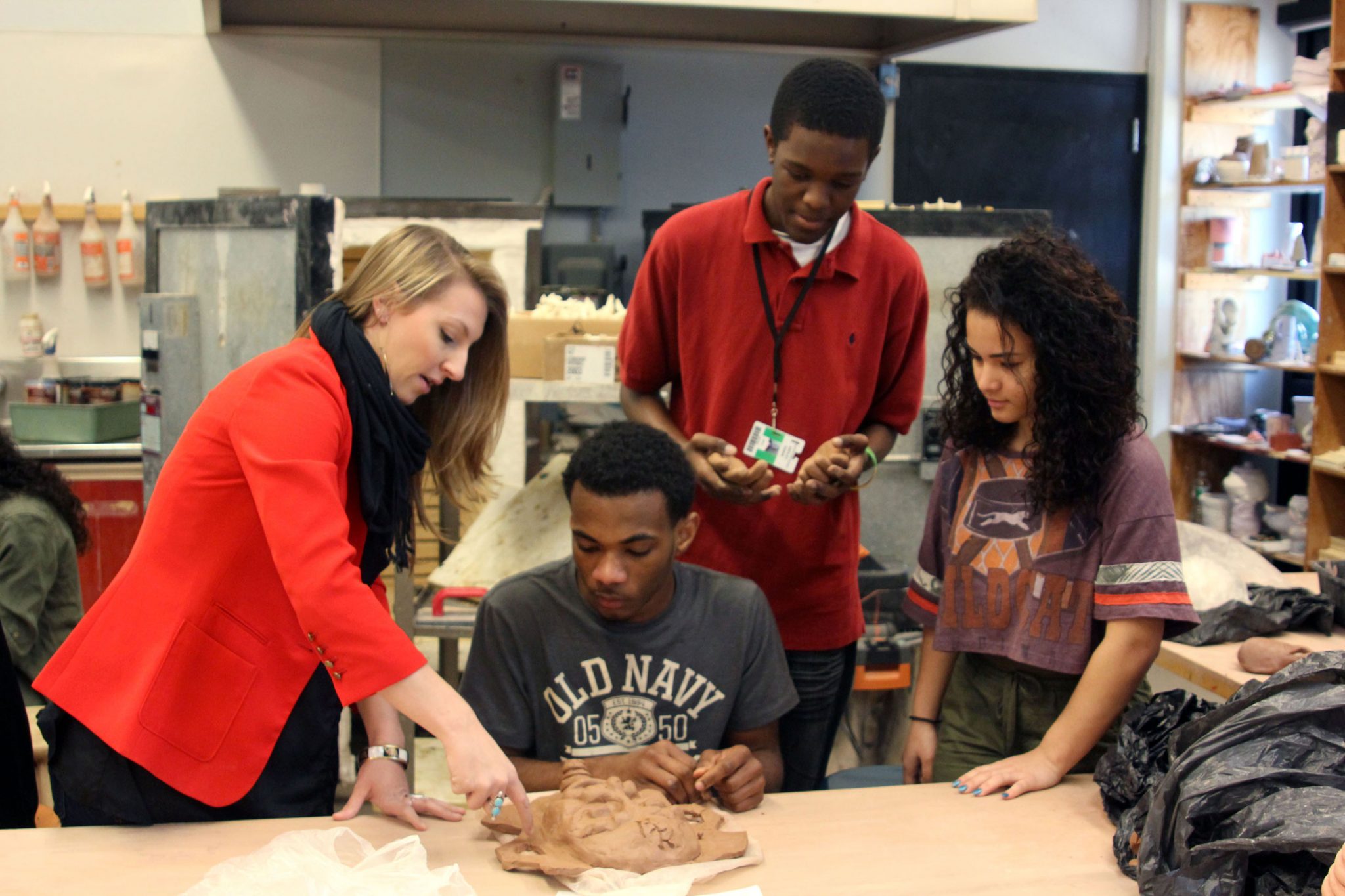
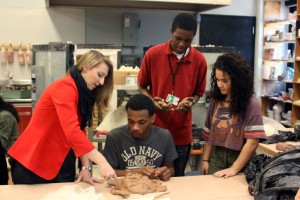
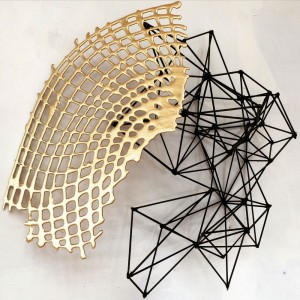
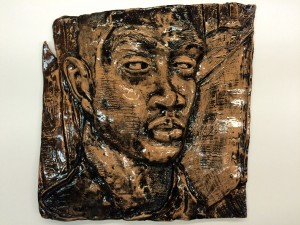
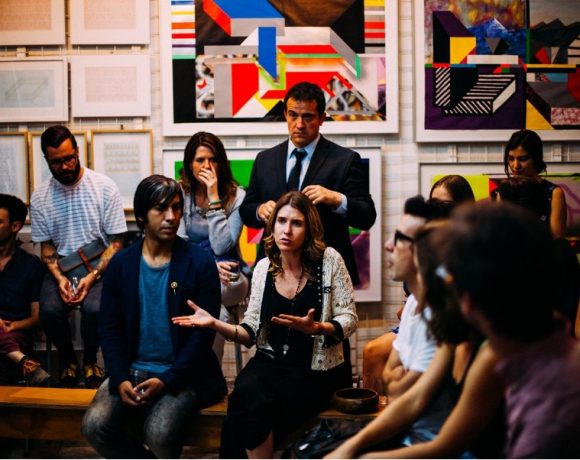

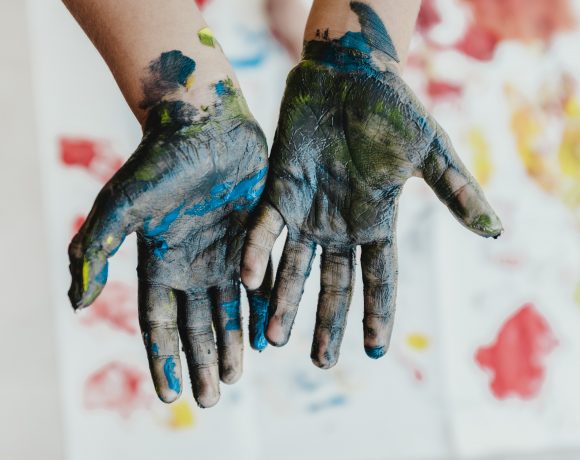




Andrea Mendoza
6 May
I was a student of Miss Blood and am looking forward to next year as a sophomore. She helps and compliments your work giving a support that makes you not want to give up on your work if your struggling. I started to work with art because my biggest inspiration is love. seeing love and trying to connected to nature, i am a very innocent when it comes to my thoughts i thank every art teacher at Brockton high school. Art has become a way of expression for me and makes me happy to have found this website and read what my teacher had to say about what art means to her. As i thank my brother for being their for me and supporting me at an art show that took place on May 2,my brother was their for me and tried to tel me what certain art works could mean….. I was very happy to have that felling and given a reason for my brother to know go back to art because hes amazing. drawing, painting, and ceramics has been a great experience that i want to continue and see what will be of my art experience.. “Love is everything in the world, the one thing that you should fight for….. the one thing you can give up on but you shall never forget because it lives in your heart… if it escaped so what part of it is still locked inside.” love will always be part of my art work as its all i need to demonstrate that a painting is more than a hobby or paint, pencil marks but an image expression.